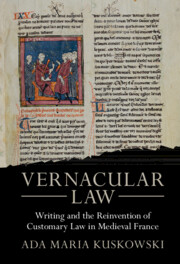Book contents
- Vernacular Law
- Studies In Legal History
- Vernacular Law
- Copyright page
- Dedication
- Contents
- Figures
- Acknowledgments
- A Note on the Text
- Introduction Vernacular Writing and the Transformation of Customary Law in Medieval France
- Part I Written Custom and the Formation of Vernacular Law
- 1 What Is Custom? Concept and Literary Practice
- 2 Composing Customary Law as a Vernacular Law
- 3 Writing a ‘ius non scriptum’: Writtenness, Memory, and Change
- Part II Political and Intellectual Tensions
- Part III Implications
- Conclusion Lasting Model and Professional Community
- Bibliography
- Index
2 - Composing Customary Law as a Vernacular Law
from Part I - Written Custom and the Formation of Vernacular Law
Published online by Cambridge University Press: 27 October 2022
- Vernacular Law
- Studies In Legal History
- Vernacular Law
- Copyright page
- Dedication
- Contents
- Figures
- Acknowledgments
- A Note on the Text
- Introduction Vernacular Writing and the Transformation of Customary Law in Medieval France
- Part I Written Custom and the Formation of Vernacular Law
- 1 What Is Custom? Concept and Literary Practice
- 2 Composing Customary Law as a Vernacular Law
- 3 Writing a ‘ius non scriptum’: Writtenness, Memory, and Change
- Part II Political and Intellectual Tensions
- Part III Implications
- Conclusion Lasting Model and Professional Community
- Bibliography
- Index
Summary
This chapter argues that the French coutumiers are part of a Europe-wide vernacular legal revolution. Traditional narratives set these texts within the transition from custom to law, or as attempts to make custom more elegant in the face of a sense of inferiority to Roman law. The question of language of these early written customs has received little attention since outdated debates between Romanists and Germanists over whether custom originated in primordial Germanic tribes or was a disguised spin-off of university legal studies. However, language was key to the development of a written customary law. Vernacular writing in Europe began in earnest in the later twelfth century and proliferated afterwards. Coutumier authors chose to ride this wave of vernacular writing, rejecting the language of the universities and traditional written record in favour of the language of new histories, epics, and romance. The coutumiers were part of the new vernacular culture; it was a literature of lordship and dispute resolution in the lay courts for a lay public who lived in the vernacular.
- Type
- Chapter
- Information
- Vernacular LawWriting and the Reinvention of Customary Law in Medieval France, pp. 89 - 125Publisher: Cambridge University PressPrint publication year: 2022

